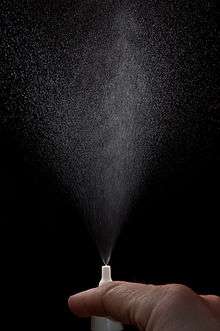Nicotine patch
A nicotine patch is a transdermal patch that releases nicotine into the body through the skin. It is used as an aid in nicotine replacement therapy (NRT), a process for smoking cessation.
Medical uses
Dozens of clinical trials have shown that the patch approximately doubles success rates over placebo treatment. Placebo tests show a 5.9% success rate, in comparison to the 7.2% blind active tests, and the 10.8% open tests.[1][2][3]
Side effects
Analysis of nicotine patches has shown that they contain tobacco-specific nitrosamines (TSNAs), known cancer-causing agents, in quantities of up to 173 mg per patch.[4]
History
The first study of the pharmacokinetics of a transdermal nicotine patch in humans was published in 1984[5] by Jed E. Rose, Ph.D., Murray E. Jarvik, M.D., Ph.D. and K. Daniel Rose, and was followed by publication by Rose et al. (1985) of results of a study of smokers showing that a transdermal nicotine patch reduced craving for cigarettes.[6] Frank Etscorn Ph.D. filed a patent in the United States on January the 23rd 1985 and was issued the patent on July 1, 1986.[7] The University of California filed a competing patent application nearly 3 years after Etscorn's filing on February the 19th, 1988, which was granted on May 1, 1990.[8] Subsequently, the U.S. Patent Office declared an interference action and, after a thorough review of conception, reduction to practice and patent filing dates, issued on September 29, 1993 a priority decision in favor of the Rose et al. patent.[9]
Research
Nicotine patches are under study to help relieve the symptoms of post-surgical pain[10] and treat early dementia.[11]
Studies are being conducted about the use of transdermal nicotine patches to treat anxiety, depression, and inattentiveness in subjects with ADHD.[12]
Transdermal nicotine patches can be used to relieve ulcerative colitis symptoms. However, this is not the case with Crohn's disease, a similar health condition, where smoking and nicotine intake in general worsen the disease's effects.
See also
References
- ↑ Renshaw, Amy. "The Real Story Behind the Nicotine Patch and Smoking Cessation". vanderbilt.edu. Vanderbilt University. Retrieved 25 November 2013.
- ↑ Fiore MC, Jaén CR, Baker TB, et al. Treating Tobacco Use and Dependence: 2008 Update. Quick Reference Guide for Clinicians. Rockville, MD: U.S. Department of Health and Human Services. Public Health Service. April 2009
- ↑ In India, Rusan Healthcare has launched the Nicotine Transdermal Patches under the Tradename '2baconil'
- ↑ UCSF Library, 3 Feb 1995, Tobacco-Specific N-Nitrosamines in Nicotine Patches, retrieved 11 Aug 2013.
- ↑ Rose, J. E.; Jarvik, M. E.; Rose, K. D. (1984). "Transdermal administration of nicotine". Drug and Alcohol Dependence. 13 (3): 209–213. doi:10.1016/0376-8716(84)90061-9. PMID 6734425.
- ↑ Rose, J. E.; Herskovic, J. E.; Trilling, Y.; Jarvik, M. E. (1985). "Transdermal nicotine reduces cigarette craving and nicotine preference". Clinical pharmacology and therapeutics. 38 (4): 450–456. doi:10.1038/clpt.1985.203. PMID 4042528.
- ↑ US 4597961, Etscorn, FT
- ↑ US 4920989
- ↑ OLIVIA M. DUVALL (21 February 1995). "Adverse Decisions in Interference". Board of Patent Appeals & Interferences. Retrieved 25 November 2013.
- ↑ "Nicotine Patch Decreases Post Surgical Pain". MediLexicon International Ltd, Bexhill-on-Sea, UK. 15 October 2007. Retrieved 25 November 2013.
- ↑ "Nicotine Patches Up Early Memory Loss In Study". 9 January 2013. Retrieved 3 February 2014.
- ↑ Cocores,, James A. (2008). "Transdermal Nicotine in Adult ADHD With Depression and Anxiety". National Center for Biotechnology Information, U.S. National Library of Medicine. Retrieved 25 November 2013.
-solution.jpg)


